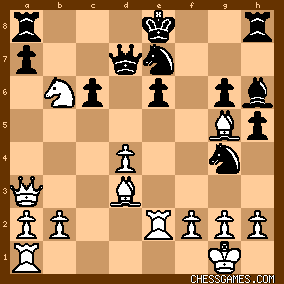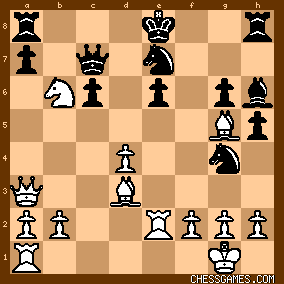|
< Earlier Kibitzing · PAGE 4 OF 4 ·
Later Kibitzing> |
| Apr-08-16 | | ndg2: Switched the move order (first Nxd5 and then e6), but black will escape here because the knight can be taken with that move order. It's not possible with the game continuation. |
|
| Apr-08-16 | | diagonalley: darn... got the first move, but missed the follow-up... <diagonalley>: nul points :-( |
|
| Apr-08-16 | | alshatranji: alshatranji: Fascinating problem. I think it was yesterday that someone said something about chess being like music. You know the keys and notes, etc, but you need to play them in the right combination and tempo (or something like that). Today's puzzle is a perfect example. I thought of e6 immediately. Black has to capture, but after that nothing is decisive. Re1 is fine, but Black has the time to protect his pieces; g6 is weakened, but it's still protected by the knight. Then I found Nxd5, which looked great: Black cannot capture with the pawn, but then the knight is protecting d5. Here I briefly considered and dismissed Nb5. It looks elegant: the Knight cannot be captured for the same reason, but there is no real threat. I had to go over the lines again, and at one point they started to coalesce. I think the key factor is that the black knight is protecting both g6 and d5, so you can remove it from one to attack the other. In other words, you have to play the two lines, one after the other. Then everything came into focus, a blinding flash, and all was clear. |
|
| Apr-08-16 | | gofer: Black's position is miserable.
Ng4 is going nowhere fast.
Ne7 going anywhere just opens up the X-ray attack from Bg4 and Qa3 meaning black's king is even more exposed.
Ra8 and Rh8 are waiting to be castled into the middle of the board, but doing so loses a piece.
Ke8 is waiting to be castled into the edge of the board, but doing so loses a piece.
Qd7 has to sit near Ne7 to stop mate.
Bg7 can only go to f8 (blocking kingside castling) because Bh6 Bxe7 Qxe7 h3 loses Ng4!
Pf7 going to f6 or f5 just opens up the e file for white's rooks.
Pc6 going to c5 at best just loses a pawn, at worst it allows Bxe7 Qxe7 Qxe7 Kxe7 Nxd5+ creating mayhem! Black really has nothing to offer in the way of a defence or an attack and its not even black to move!!! There is so many weak squares for white to pick on; e6, g6, g4 and e7 so lets add a few more; c7 and d6! <18 Nb5! ...>

click for larger viewThe knight is immune.
18 ... cxb5
19 Bxb5! 
Not castling invites a beautiful attack ripping black's position to pieces... 18 ... c5 (or similar)
19 Nd6+ Kf8
20 Nxf7! 
Trying to defend against Nd6+ is horrible...
18 ... Nf5
19 Bxf5 gxf5
20 Nd6+ Kf8
21 Nf7+! 
Castling loses a piece ...
18 ... O-O-O (from this point on cxb5 is suicidal)
19 Bxe7 
18 ... O-O
19 Qxe7 Qxe7
20 Bxe7 Rfc8
21 Nd6 Rc7
22 Bg4 
So what can black do?!
18 ... Kf8
19 Nd6 
Black's position is horrible Nxf7 is coming and there isn't a whole lot black can do about it! ~~~
Doh! I was wondering whether I made this too complicated... |
|
Apr-08-16
 | | rodchuck: I wondered about 18.Nb5 threatening 19.Nd6+ and 20.Nxf7. If20... Kxf7 Then 21.e6 snags the queen. If 18...c*b5, then 19. Bxb5 removes the queen, allowing mate. |
|
Apr-08-16
 | | rodchuck: I see gofer beat me to it |
|
| Apr-08-16 | | agb2002: White has the bishop pair for a bishop and a knight. White can try to exploit the position of the black king by opening lines with 18.Nb5, 18.Nxd5, 18.e6, etc. In the case of 18.Nb5 Nf5 (18... cxb5 19.Bxb5 wins) seems to hold. -----
In the case of 18.Nxd5
A) 18... cxd5 19.Bb5
A.1) 19... Qxb5 20.Qxe7#.
A.2) 19... Nc6 20.Bxc6 wins.
A.3) 19... Bf8 20.Bxd7+ + - [Q+P vs 2N].
B) 18... Nxd5 19.e6
B.1) 19... fxe6 20.Bxg6+ Qf7 21.Rxe6+ wins.
B.2) 19... Qc7 20.Rae1 (20.exf7+ Kxf7 21.Rae1 Rhe8) 20... Nge3 returning the piece seems to hold. -----
The line B.2 after 18.Nxd5 suggests 18.e6 fxe6 (18... Qc7 19.exf7+ followed by 20.Rxe7 wins) 19.Nxd5: A) 19... cxd5 20.Bb5 as A after 18.Nxd5.
B) 19... Nxd5 20.Bxg6+ as B.1 above.
C) 19... Qxd5 20.Qxe7#.
D) 19... Bf8 20.Rxe6
D.1) 20... Qxe6 21.Nc7+ Kd7 22.Nxe6 Kx6 23.Re1+ wins. D.2) 20... Qxd5 21.Rxe7+ Kd8 (21... Bxe7 22.Qxe7#) 22.Rxa7+ Qxg5 23.Rxa8+ followed by 24.Qa7+ and h3 (to prevent Qh4) wins an exchange at least with a much better position. D.3) 20... cxd5 21.Bb5 Qxb5 22.Rxe7+ Kd8 23.Rf7+ wins decisive material (23... Ke8 24.Rxf8+ Rxf8 25.Qe7#). -----
I think I'd play 18.e6. |
|
| Apr-08-16 | | The Kings Domain: Nice and pretty deep puzzle. Got the first move, missed the follow-up. Impressive build-up by white in attacking black's weak center. |
|
| Apr-08-16 | | goodevans: Looking through the kibitzing I see I wasn't alone in getting the right moves in the wrong order. Well, at least I had company! |
|
| Apr-08-16 | | morfishine: I got <18.e6> but certainly not <19.Nxd5> |
|
| Apr-08-16 | | ozu: Black and Blau |
|
| Apr-08-16 | | Coriolis: After some time I went for 18. Nxd5 instead of my initial intuition of 18. e6. (assuming 18. e6 was best...) Was that a sound move? |
|
| Apr-08-16 | | 1.e4effort: Why not push the pawn and sac the rook? If the Queen doesn't take, kill the Knight , then she'll have to take and its over. Right? What am I missing? |
|
Apr-08-16
 | | Dionysius1: The tactics 19 Nxd5 where neither pawn can take the N, and 20 Bxf5 when 20...gxf5 loses to 21 Rxe6 Qxe6 22 Nc7 are very pretty! |
|
| Apr-08-16 | | JASAHA: Ha, I guess before there was castling there were more puzzles like this! |
|
| Apr-08-16 | | saturn2: Why did black not play 19..Bf8? |
|
| Apr-08-16 | | Timi Timov: 18. e6 was the first move I thought of. But later I chose 18. Nxd5. Is that worse? |
|
Apr-08-16
 | | Jimfromprovidence: There is a very satisfying solution to this side puzzle after 19...Bh6.
click for larger view White to play and win. |
|
| Apr-08-16 | | saturn2: <Jimfromprovidence after 19...Bh6 White to play and win.> 20 NxNe7 BxBg5 21 Nxg6 seems to win. And 20 Nxb6 Qd8 21 NxRa8 BxBg5 22 Qxa7 seems also an easy win for white. |
|
| Apr-08-16 | | goodevans: <saturn2: <Jimfromprovidence after 19...Bh6 White to play and win.> 20 NxNe7 BxBg5 21 Nxg6 seems to win. And 20 Nxb6 Qd8 21 NxRa8 BxBg5 22 Qxa7 seems also an easy win for white.> But 19...Bh6 20.Bxe7 seems most convincing of all (20...cxd5 21.Bxg6#) |
|
| Apr-08-16 | | saturn2: <goodevans But 19...Bh6 20.Bxe7 seems most convincing of all (20...cxd5 21.Bxg6#)> 20 Bxe7 QxNd5 is no mate 21 Bg6+ Kd7 white has only won a pawn |
|
| Apr-08-16 | | goodevans: 19...Bh6 20.Bxe7 Qxd5 21.h3 and white wins at least a piece. |
|
Apr-08-16
 | | Jimfromprovidence: <saturn2> <goodevans>. Both of your lines look winning. I got into the 19...Bh6 20 Nxb6+ line myself beacase of two wrinkles I noticed. 
click for larger viewThe first is after 20...Qc7.

click for larger viewHere 21 Nxa8?? loses right away to 21...Qxh2+
So white wins after 21 Qxe7+ Qxe7 22 Bxg6+!, below.
(This is better than 22 Bxe7 directly because black cannot follow with 22...axb6. With 22 Bxg6+ white can pick up a knight vs. rook exchange as well as a couple of pawns). 
click for larger view |
|
Aug-21-19
 | | MissScarlett: <Beaten Black and Blau> |
|
Feb-26-25
 | | kingscrusher: 19.Nxd5 is an emphatic crushing move despite the number of times it is protected! |
|
 |
 |
|
< Earlier Kibitzing · PAGE 4 OF 4 ·
Later Kibitzing> |





